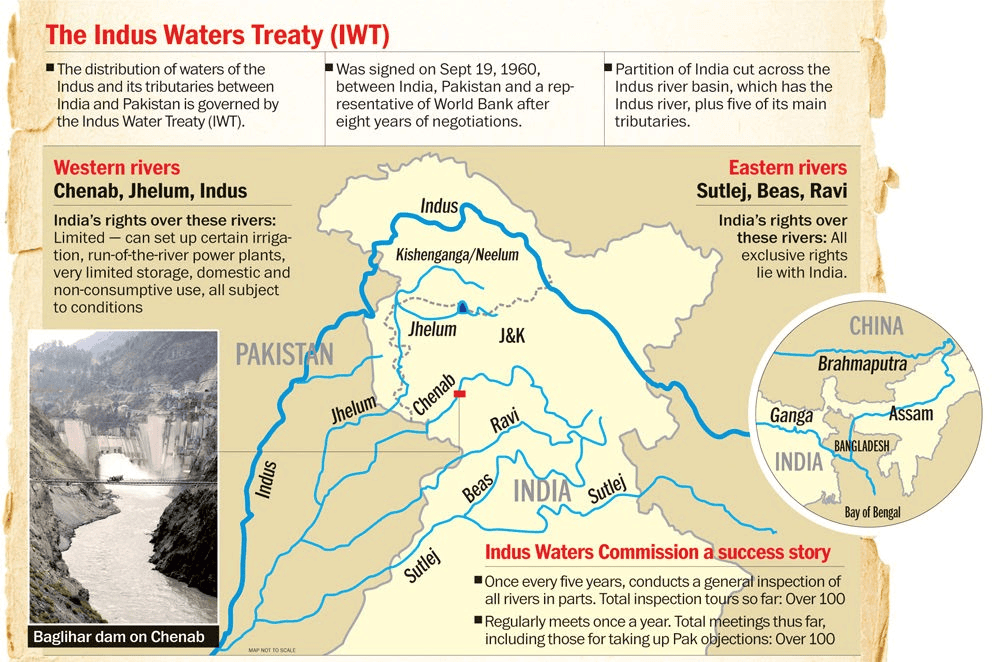The Hindu Editorial Analysis- 21st September 2024 | Current Affairs & Hindu Analysis: Daily, Weekly & Monthly - UPSC PDF Download

Staunch the Breach
Why in News?
In its fourth notice to Pakistan since January 2023, India has escalated its demand for the renegotiation of the 1960 Indus Waters Treaty (IWT), now calling of all meetings of the Permanent Indus Commission (PIC) until Pakistan agrees to sit at the table for talks. India’s demand last year followed a logjam in the entire process, once held up internationally as a model template for water-sharing agreements.
What is Indus Water Treaty (IWT)?
The Indus Waters Treaty was signed on September 19, 1960, between India and Pakistan, with the help of the World Bank.
This treaty provides a way for both countries to cooperate and share information regarding the use of the Indus River and its five tributaries: Sutlej, Beas, Ravi, Jhelum, and Chenab.
Key Provisions
- Water Sharing:
- The treaty explains how water from the six rivers of the Indus River System should be shared between India and Pakistan.
- It allows Pakistan to use the three western rivers: Indus, Chenab, and Jhelum freely, with some restrictions on non-consumptive, agricultural, and domestic uses by India.
- India has unrestricted use of the three eastern rivers: Ravi, Beas, and Sutlej.
- This setup means that approximately 80% of the water share is for Pakistan, while 20% is for India.
- Permanent Indus Commission:
- Both countries are required to establish a Permanent Indus Commission, which is supposed to meet every year.
- Dispute Resolution Mechanism:
- The treaty includes a three-step process to resolve disputes.
- Questions from either side can first be addressed at the Permanent Commission or escalated to the inter-government level.
- If issues remain unresolved, a Neutral Expert appointed by the World Bank can step in to help.
- Further appeals from the Neutral Expert can be taken to a Court of Arbitration established by the World Bank.
- Projects to be Inspected Under IWT:
- Pakal Dul and Lower Kalnai:
- The Pakal Dul Hydro Electric Project is on the Marusudar River, a tributary of the Chenab.
- The Lower Kalnai project is also based on the Chenab River.
- Kishanganga Hydroelectric Project:
- This is a run-of-the-river project located in Jammu and Kashmir.
- Pakistan raised concerns that this project would impact the flow of the Kishanganga River (known as the Neelum River in Pakistan).
- In 2013, the Permanent Court of Arbitration in The Hague ruled that India could divert the water with certain conditions.
- Ratle Hydroelectric Project:
- This project is a run-of-the-river hydroelectric power station on the Chenab River in Jammu and Kashmir.
- Pakal Dul and Lower Kalnai:

Indus River and its Tributaries
The Indus River, known as the Sengge Chu or "Lion River" in Tibetan, is a significant river in South Asia. It originates in Tibet, near Mansarovar Lake in the Trans-Himalaya region.After starting its journey in Tibet, the Indus River flows through India and Pakistan, with approximately 200 million people living in its drainage basin.
Course and Major TributariesThe Indus River enters India through Ladakh and flows through the regions of Jammu and Kashmir before crossing into Pakistan's Gilgit-Baltistan region.Left-Bank Tributaries: The major tributaries joining the Indus River from the left bank include the Zaskar, Suru, Soan, Jhelum, Chenab, Ravi, Beas, Satluj, and Panjnad rivers.Right-Bank Tributaries: The major tributaries joining from the right bank are the Shyok, Gilgit, Hunza, Swat, Kunnar, Kurram, Gomal, and Kabul rivers.The Indus River eventually empties into the Arabian Sea, near the city of Karachi in southern Pakistan.
River | Source | Joins |
Jhelum |
|
|
Chenab |
|
|
Ravi |
|
|
Beas |
|
|
Satluj |
|
|
Way Forward
- Focus on Technical Dispute Resolution: Both parties should make it a priority to use the existing framework of the treaty for settling technical disagreements.
- Transparency and Data Sharing: Both countries can exchange hydrological data to tackle shared concerns effectively.
- Joint Basin Management: Challenges like climate change and rising population in the Indus basin highlight the need for cooperative management to conserve water, control floods, and ensure sustainable use.
- Political Commitment and Dialogue: Finding lasting solutions requires both governments to commit to prioritizing conversation and collaboration rather than conflict.
|
44 videos|5271 docs|1113 tests
|
















